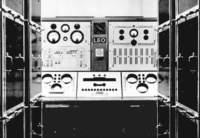EDSAC runs its first program
|
6th May 1949 The Electronic Delay Storage Automatic Calculator (EDSAC) was the first practical stored-program computer to operate a regular computing service. EDSAC was built by Maurice Wilkes at the University of Cambridge Mathematical Laboratory. On 6th May 1949, EDSAC performed its first calculation, running a program written by Beatrice Worsley to calculate the squares of numbers. J. Lyons & Co. Ltd., a British firm, helped fund the EDSAC project with a grant of £3000. In return, Lyons were given permission to build a copy once EDSAC was complete. The Lyons machine based on the EDSAC design, LEO I, was the first commercial computer. EDSAC used the following components:
Related information:
Image:
Related Items in the Collection:
|
Click on the Images For Detail
|













